Janeen Webb - Interview by SE
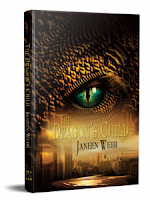 The Dragon's Child - 2018
The Dragon's Child - 2018 by Janeen Webb
It is not intuitive to seek beauty in art deemed grotesque/weird, but most authors who produce horror/fantasy are usually (a) serious about their craft, and (b) driven my strange muses. These interviews engage contemporary authors & artists on the theme of “Beauty in Weird Fiction" This one features Janeen Webb, award-winning fantasy author and lover of vintage weird fiction.
Janeen Webb can spin a a fantastic tale for the young-adult (YA) crowd as well as for adult acolytes of weird-fiction (see below excerpt from "A Pearl Beyond Price" which involves beach sex with Cthulhu-esque tentacles!). She is clearly haunted by Eros, and compelled by a weird-but-beautiful muse.
Let us learn a bit from her experienced voice & ear. Some of my favorite lines are highlighted by me, SE. You may never look at red roses the same way ever again!
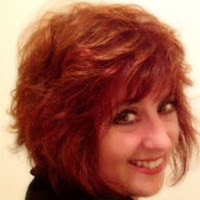 BIO: Janeen Webb is a multiple award-winning author, editor, and critic who has written or edited ten books and over a hundred essays and stories. She is a recipient of the World Fantasy Award, the Peter MacNamara SF Achievement Award, the Australian Aurealis Award, and is a four-time winner of the Ditmar Award. Her short fiction has appeared in a wide range of magazines and anthologies, as well as a number of Best of the Year collections. Her own collection, Death at the Blue Elephant, (Ticonderoga Publications) was shortlisted for the 2015 World Fantasy Award. Her longer fiction includes a series of novels for young adult readers, The Sinbad Chronicles, (HarperCollins, Australia). Her latest book is The Dragon's Child, due for June release from PS Publications. She is also co-editor, with Jack Dann, of the influential Australian anthology Dreaming Down-Under. Janeen has also co-authored several non-fiction works with Andrew Enstice. These include Aliens and Savages; The Fantastic Self; and an annotated new edition of Mackay’s 1895 scientific romance, The Yellow Wave. Janeen is internationally recognized for her critical work in speculative fiction. Her criticism has appeared in most of major journals and standard reference works, as well as in several collections of scholarly articles published in Australia, the USA, and Europe. She was co-editor of Australian Science Fiction Review, and reviews editor for Eidolon. She holds a PhD in literature from the University of Newcastle. Janeen divides her time between Melbourne and a small farm overlooking the sea near Wilson’s Promontory, Australia.
BIO: Janeen Webb is a multiple award-winning author, editor, and critic who has written or edited ten books and over a hundred essays and stories. She is a recipient of the World Fantasy Award, the Peter MacNamara SF Achievement Award, the Australian Aurealis Award, and is a four-time winner of the Ditmar Award. Her short fiction has appeared in a wide range of magazines and anthologies, as well as a number of Best of the Year collections. Her own collection, Death at the Blue Elephant, (Ticonderoga Publications) was shortlisted for the 2015 World Fantasy Award. Her longer fiction includes a series of novels for young adult readers, The Sinbad Chronicles, (HarperCollins, Australia). Her latest book is The Dragon's Child, due for June release from PS Publications. She is also co-editor, with Jack Dann, of the influential Australian anthology Dreaming Down-Under. Janeen has also co-authored several non-fiction works with Andrew Enstice. These include Aliens and Savages; The Fantastic Self; and an annotated new edition of Mackay’s 1895 scientific romance, The Yellow Wave. Janeen is internationally recognized for her critical work in speculative fiction. Her criticism has appeared in most of major journals and standard reference works, as well as in several collections of scholarly articles published in Australia, the USA, and Europe. She was co-editor of Australian Science Fiction Review, and reviews editor for Eidolon. She holds a PhD in literature from the University of Newcastle. Janeen divides her time between Melbourne and a small farm overlooking the sea near Wilson’s Promontory, Australia.1) Hearing/reciting Weird BeautySE: We were introduced on a panel about “The Eternally Difficult (but Fascinating) Writers ” at the 2016World Fantasy Convention in which you, on the fly/unscripted, recited the poetic introduction to E.R.R. Edison’s 1935 Mistress of Mistress. The following year at the next WFC, you participated in a Lord Dunsany reading. There is no doubt that you hold esteem for aural beauty of weird fiction. Many questions emerge from this: How does listening/reciting help convey beauty? With the rise of audible books, hearing fiction is becoming popular and accessible: any perspective on this? What works do you like to hear, recited by whom?
JW: I do, indeed, love the beauty of words. We are all hard-wired to respond to the inherent sounds that words on the page represent. The music they make determines how we understand meaning. We know, instinctively, how this works: in everyday situations we listen for clues in tone and delivery, and we react accordingly. Even the most neutral words change meaning according to context: an angry person breaks them into short, sharp shocks; politicians use sound bites that snap their jaws at us; loved ones reassure us with softer, longer phrases. In literature, the pace and patterning of words on the page tells us how to read the text, and it often helps to read it aloud. Some poets, like Gerard Manley Hopkins (one of my favourites), are impossible to appreciate if you don'tread them aloud. Hopkins is a good case in point here: his subject matter is often very dark, but the music of his writing is superb. As writers, I think we all strive for nuanced beauty.
 Fantasy writers have always used the music of words to great effect. Tolkien, for example, created whole languages to differentiate his characters: compare the mellifluous, silvery tones of Elvish with the harsher language of the Dwarves and the terrifying sounds of the monosyllables that come out of Mordor. The point I was making on the WFC panels is that "difficult" writers such as Eddison and Dunsany are worth persevering with for the sheer beauty of their language. Hearing works such as Mistress of Mistresses read aloud changes the way we respond to them, and I think that the relaxed process of engaging with talking books is bringing storytellers closer to their audiences once again. We all grew up listening to stories - why wouldn't we want to keep hearing them?
Fantasy writers have always used the music of words to great effect. Tolkien, for example, created whole languages to differentiate his characters: compare the mellifluous, silvery tones of Elvish with the harsher language of the Dwarves and the terrifying sounds of the monosyllables that come out of Mordor. The point I was making on the WFC panels is that "difficult" writers such as Eddison and Dunsany are worth persevering with for the sheer beauty of their language. Hearing works such as Mistress of Mistresses read aloud changes the way we respond to them, and I think that the relaxed process of engaging with talking books is bringing storytellers closer to their audiences once again. We all grew up listening to stories - why wouldn't we want to keep hearing them?My choice for which vintage voice actor I like best is Richard Burton: I love his old recording of Dylan Thomas' Under Milk Wood, but my all-time favourite is his narration of H.G. Wells' classic SF novel, The War of the Worlds, for Jeff Wayne's extraordinary 1978 musical version. Burton's reading still makes the hairs on the back of my neck stand on end. I've been driving around listening to it lately because I've just finished writing a new, Australian-flavoured take on War of the Worlds - "Apostles of Mercy"- for an anthology slated for publication towards the end of this year. It was great fun to write.
2) Erotic MusesSE: Your collection of weird stories, The Death at the Blue Elephant features most every type of tale imaginable: from Lewis Carroll-like fairytales, to contemporary horror (the titular story), to Lovecraftian Mythos, Arthurian legends, historical fantasy, Faustian deals, and Phillip-Dick-like Sci-Fi. Great stuff, with a bent toward mature readers. Especially since most exhibit a dose of eroticism with horrific undertones (i.e., the title story, Niagara Falling, & Red City). Does Eros haunt you? Please discuss blending of beauty/attraction with horror. What scares you? Is it beautiful?
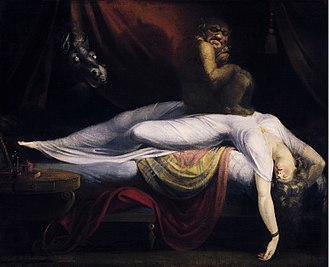 Henry Fuseli's The Nightmare - 1781JW: Does Eros haunt me? Of course, it does. Seth introduced me as a lover of vintage weird, which is pretty accurate: the description immediately makes me think of Fuseli's famous painting of a grotesque creature crouched on the chest of a woman sprawled in sleep - The Nightmare - made real.My own work is like that. I often literalize the metaphors that haunt the modern psyche - as, for example, in the title story "Death at the Blue Elephant", where Death has chosen to manifest as a goth-chic, stalking her ill-fated clients in a trendy cafe-bar. And this avatar of Death is a very naughty girl.
Henry Fuseli's The Nightmare - 1781JW: Does Eros haunt me? Of course, it does. Seth introduced me as a lover of vintage weird, which is pretty accurate: the description immediately makes me think of Fuseli's famous painting of a grotesque creature crouched on the chest of a woman sprawled in sleep - The Nightmare - made real.My own work is like that. I often literalize the metaphors that haunt the modern psyche - as, for example, in the title story "Death at the Blue Elephant", where Death has chosen to manifest as a goth-chic, stalking her ill-fated clients in a trendy cafe-bar. And this avatar of Death is a very naughty girl.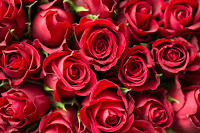 The two great driving forces of literature are Eros and Thanatos, sex and death, and the one begets the other. It could hardly be otherwise. The two are hopelessly entwined. Repulsion is the underside of attraction, and you can't have one without the other. We prettify basic human instincts, but even the most cliched images of romantic love are saturated with darker sexual truths: if you think about it, that gorgeously symbolic bouquet of red roses is actually a bunch of the sexual organs of plants, severed and tied up with ribbons. What you see is just a question of how you choose to look at it, and whether or not you're prepared to peer beyond the rose-colored lenses of convention.
The two great driving forces of literature are Eros and Thanatos, sex and death, and the one begets the other. It could hardly be otherwise. The two are hopelessly entwined. Repulsion is the underside of attraction, and you can't have one without the other. We prettify basic human instincts, but even the most cliched images of romantic love are saturated with darker sexual truths: if you think about it, that gorgeously symbolic bouquet of red roses is actually a bunch of the sexual organs of plants, severed and tied up with ribbons. What you see is just a question of how you choose to look at it, and whether or not you're prepared to peer beyond the rose-colored lenses of convention.I'm a fan of the metaphysical poets, with their dark insistence on mortality - think of John Donne, posing in his shroud for a sculptor. I'm a fan of the sheer sex-and-death mayhem that characterises Jacobean tragedy. And I'm a fan of Romantic/Gothic sensibility: the erotic haunting of Seth's question is a particularly Gothic concept, encompassing the attraction of the forbidden, most usually embodied in creatures such as vampires - where sexual embrace also enfolds the false immortality of life-in-death. Living forever is attractive, but at what cost? It's a Frankenstein question, and one that increasingly haunts modern medicine.
My stories engage with the emotional truths we don't often care to acknowledge. What scares me most is routine cruelty camouflaged as mundane behaviour: scratch the surface of perceived reality, look into the shadows - you will find the worst abuses delivered with a bureaucratic smile, glossed over by socially acceptable cliches. And if that doesn't scare you, it should.
3) Self-reflection SE: Do you find beauty in your weird fiction? Dissect an example.
JW: That's a hard thing to ask a writer to do: the fiction should speak for itself. But the short answer to your question is "yes" - I do find beauty in writing weird fiction. How could I not? Stories are organic things: I'm not sure any writer really knows exactly how they are formed - I am often surprised by the way they twist and turn, sometimes shocked by the decisions my characters make. I'm reluctant to dissect a story, to take it apart, but I can give you a short "weird-but-beautiful" example from a recent one. I've chosen "A Pearl Beyond Price," partly because it won this year's Ditmar Award (Australia's National F&SF Award), and partly because it was written for the 2017 Cthulhu Deep Down UnderAnthology, and it doesn't get much weirder than that.
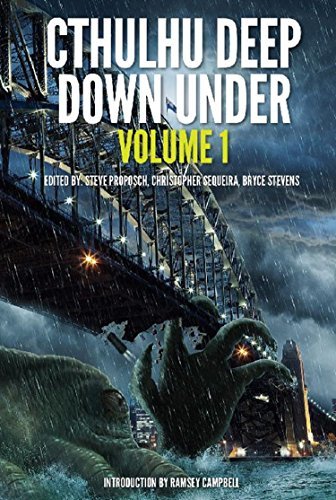 "A Pearl Beyond Price" is a lyrical horror story - a variation on Beauty and the Beast. My inspiration for it was Hokusai's famous woodblock print, "The Dream of the Fisherman's Wife" - I saw the original when the British Museum staged an exhibition of Japanese Shunga a few years ago.
"A Pearl Beyond Price" is a lyrical horror story - a variation on Beauty and the Beast. My inspiration for it was Hokusai's famous woodblock print, "The Dream of the Fisherman's Wife" - I saw the original when the British Museum staged an exhibition of Japanese Shunga a few years ago.My protagonist is a pearl fisher from a remote coastal settlement, a lonely girl who responds to the overtures of a monster - a telepathic creature from the Cthulhu universe that exists in the deeps of the ocean. I've tried to capture the ecstasy that Hokusai portrays, and combined it with the high weirdness of the Lovecraftian mythos (not that Hokusai's image isn't already strange). You can see how the story reads from this excerpt:
"Michiko reclined against a rocky ledge, marveling at her experience. She knew she had not imagined it –the ring that now encircled her finger was proof enough of that. She lolled further back, letting the warm wavelets wash over her quivering limbs. It had been an exhausting dive. She pulled off her bandana, freeing her long black hair to tumble about her naked shoulders, its curling strands mingling with the red and brown sea wrack that swirled about her on the sand. She leaned on one elbow, feeling the kiss of the sun on her face, feeling the salt drying on her exposed skin, feeling her nipples harden in the breeze. Her senses stirred. She was still thinking about the monster, still re-living her strange encounter, a meeting that had been frightening and exhilarating all at once.
And as she lay there, the creature that lived beneath the sea put out a long tentacle to find her again. She accepted its touch, pretending not to notice its questing progress up her white thigh .... "
There's nothing even remotely creepy about this lonely girl abandoning herself to an erotic moment on a secluded beach: it's part of the natural world she inhabits, and she accepts the gift of pleasure the monster offers her in the spirit in which it is given. The true horror of her story only unfolds when a ship arrives, and sailors become entangled in her life. The story asks the eternal question: "which is the true monster?" In this case, is it the man who attacks Michiko, or the hideous creature who defends her? The idea of the monster as hero runs through a lot of modern fantasy, and this story draws upon it in various twisty ways.
You can read "A Pearl Beyond Price" in Cthulhu Deep Down Under, Vol.1, edited by Steve Proposch, Christopher Sequeira, & Bryce Stevens, (IFWG Publishing Australia, Melbourne, 2017). Available online.4) Muses and Writer’s block?
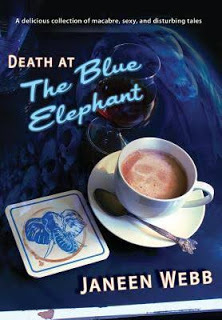 SE: The Death at the Blue Elephant has explicit call-outs to artists, including “The Sculptor’s Wife” in which a sculptor literally carves his wife from stone, and Blake’s Angel” has a creative writer craft listens to angels sing to overcome writer’s block. Blake also wrote while being naked. For the sake of keeping the interview interesting, can you confirm that you take after Blake? As in: do you listen to angels, somehow, and have ways to overcome writers block?
SE: The Death at the Blue Elephant has explicit call-outs to artists, including “The Sculptor’s Wife” in which a sculptor literally carves his wife from stone, and Blake’s Angel” has a creative writer craft listens to angels sing to overcome writer’s block. Blake also wrote while being naked. For the sake of keeping the interview interesting, can you confirm that you take after Blake? As in: do you listen to angels, somehow, and have ways to overcome writers block?JW: Writing naked? In this climate? I don't think so. But if you look beyond the inconveniences of physicality, the writing process strips us all bare to the soul, so in that sense, yes, we are all writing naked. William Blake just actualized the metaphor, taking tea naked in the garden with the archangel Gabriel. It's a wonderful image of creativity.
Ursula Le Guin once said that "those who refuse to believe in dragons are often eaten by them - from the inside." It's the same with angels. And all the creatures from all the mythologies that speak to us in the depths of our souls. Refuse to listen to them at your peril - they'll eat you alive.
Writer's block is a tricky thing. It seems to happen when the story isn't holding together, or when I'm not! But I'm always working on multiple projects, so my way of dealing with it is to put the piece aside and work on something else until I figure out what the problem is. Sometimes this takes quite a while - one of my YA protagonists was stuck in a swamp on the Nile delta for ages till I found a way to get her out again. I'm sure she was pleased to move on - I certainly was.
I'm one of those authors who doesn't write in a straight line from beginning to end - I often write dramatic sequences, or tease out subplots, then stitch all the pieces together later - I always know how my stories will end, but rarely how they'll get there, so I just work away at different bits until the thing comes clear. Or not. Not everything works. Some things end up in the "maybe later, maybe never" file. It's the nature of the writing beast.5) New WorksSE: Your Novella, The Dragon's Child, is slated for release about now (June 2018 via PS Australia). Please tell us about it.
JW: I really enjoyed writing The Dragon's Child.Here's what it says on the cover:
Meet the shapeshifting dragons of Hong Kong. Adept at passing for human, they are the kind of dragons you'd find at a Gatsby party - charming, sophisticated, glamorous, outrageously wealthy - and utterly ruthless. Nothing, it seems, can challenge their privileged lives - until Lady Feng leaves one of her eggs to be raised by human foster parents in a remote mountain village. The dragon child hatches. Born with dragon power, raised with human emotion, this child is trouble. And his powers are growing...
PS Publishing have made this a fabulous hardcover package: beautiful cover art by Greg Bridges, wonderful design and layout by Michael Smith - even the endpapers are golden dragon scales. I've never looked so good in print! Thanks, guys.
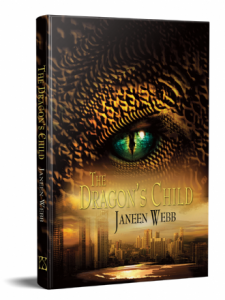 The Dragon's Child - 2018 by Janeen WebbThe Dragon's Child is a seriously different take on the eternal struggle between humanity and dragon kind. I've moved the age-old conflict from the battlefield to the board room. A cave full of glittering treasure is just so old fashioned: why would modern dragons bother collecting mere gold and gems if they can own banks and casinos? Or control multinational corporations? Our current international trade structure of perpetual wealth creation is a dragon's dream - and clearly, the Dragons are in control, guarding their positions as jealously as they ever protected their ancient hoards. I like the idea that all the cold-blooded monetary decisions are being made by actual reptiles - it makes a certain sense, don't you think? And the humans don't even know they are there - how could we? Compared with dragons, humans are such a short-lived species, and our greed makes us so very vulnerable to flattery, bribery, corruption, and judiciously applied blackmail.
The Dragon's Child - 2018 by Janeen WebbThe Dragon's Child is a seriously different take on the eternal struggle between humanity and dragon kind. I've moved the age-old conflict from the battlefield to the board room. A cave full of glittering treasure is just so old fashioned: why would modern dragons bother collecting mere gold and gems if they can own banks and casinos? Or control multinational corporations? Our current international trade structure of perpetual wealth creation is a dragon's dream - and clearly, the Dragons are in control, guarding their positions as jealously as they ever protected their ancient hoards. I like the idea that all the cold-blooded monetary decisions are being made by actual reptiles - it makes a certain sense, don't you think? And the humans don't even know they are there - how could we? Compared with dragons, humans are such a short-lived species, and our greed makes us so very vulnerable to flattery, bribery, corruption, and judiciously applied blackmail.My shapeshifting Hong Kong business dragons are a fusion of east and west, a mix of myth and fable and fairytale for the modern world. And they are gorgeous! If Faberge's exquisitely crafted eggs were to hatch, my dragons are what would emerge: the child of the title is Gold-Jade, his sister is Ruby-Gold, his cousin is Amethyst-Jade, and so on. The matriarch of the dynasty, the eminently despisable Lady Feng, is pure gold, scales and eyes; but her breeding partner is the Jade-Ruby dragon, a huge male with jade green scales and a ruby red underbelly. You get the idea: they are beautiful, and deadly. The Dragon's Child is a story of revenge, greed, and retribution - a deliberate blend of fable and dynastic thriller. And yes, I have already written a second book: A Dynasty of Dragons (currently with my agent). The next one is already haunting me, waiting to hatch. Dragons are such demanding creatures!
The Dragon's Child is available online at: www.pspublishing.co.uk
You can read a sneak preview at: http://www.pspublishing.co.uk/blog/2018/05/14/sneak-peek-extract-the-dragons-child-by-janeen-webb/
6) Artistic TeamSE: Writing is often thought of as a solo art, unlike movie production which requires a team and in which “creative differences” often plagues production. You and Jack Dann seemed to partner well and gather awards, especially for anthologies on dreaming: i.e., Dreaming Down Under and Dreaming in the Dark. What’s your take on creating solo art versus team projects, and shared muses?
JW: We all have that image in our minds, don't we? The romantic figure of the lonely writertoiling away alone, penning a masterpiece in a cobwebbed garret. But writing is a collaborative art. A writer requires a whole complex process of editing, printing, distribution and so on to reach an audience - there are a lot of people involved in getting a book out. It's not always a comfortable experience for the writer - Samuel R Delaney famously remarked that the role of an editor was to insert microdisimprovements in the text - but nevertheless, the process is there. The advent of Indie publishing circumvents some of the steps for some writers, but the physical issues of printing, distribution, and so on still require the involvement of others. And we shouldn't forget the huge army of IT professionals who create and provide the platforms that make possible our e-books and online presence.
Most of my collaborative works have been non-fiction: I've co-authored several books with fellow literary historian Andrew Enstice. For me, collaboration on non-fiction is much less confronting than co-writing fiction because it allows a certain distance between the writer and the subject matter. Collaboration on anthologies works in much the same way, in that the editors are collecting and weaving together the stories of other writers, and so they have space to step back from the works themselves. My collaboration with Jack Dann on the ground-breaking Dreaming Down-Under anthology was a huge undertaking, but our combination of skills proved very successful - we won a lot of awards, and kick-started a lot of Australian careers - so it's something we can be proud of. (The Dreaming of the title refers to the idea that writing and reading fiction is a kind of waking dream.) Collaboration between writers on creative manuscripts is a different thing, and the process is not always immediately apparent to the reader - a good case in point would be Ezra Pound's silent editing of TS Eliot's The Wasteland to produce the poem in its final form. But when there are two (or more) writers overtly working on fiction together, when we all have skin in the game, things can get very gnarly! I'm a relative newcomer to writing fiction, and I'd only published a couple of stories before I tried a collaboration with Jack Dann: it was OMNI Magazine's Keith Ferrell who suggested we write together for his Japanese Futures anthology. Jack enjoys collaborating: he has published a lot of co-authored works, and he's amazingly good at it. But for me it was an incredibly steep learning curve. The stories were very successful - "Niagara Falling" is still being reprinted - but we were barely on speaking terms by the time we'd finished it. A case, perhaps, of angst creating art, but at the time I felt it wasn't for me, and I went back to writing solo fiction.
Years later, I'm only just trying fictional collaboration again, but in a very different way. Under the guidance of Clio, muse of history, I've been working with Andrew Enstice once more - this time on a counterfactual history in novel form, The City of the Sun, where the facts are true, but the outcomes are different. This is history with a twist, a story of a world that might have been if we had persevered with solar energy - which was perfectly possible, given that successful solar-powered steam engines were invented in the 1870s (and the biggest solar array in the world was built in Egypt in 1913 - just in time to be destroyed in World War I). So: do things really have to be as they are? Of course not. City of the Sun is a future you'll wish we'd had. Stay tuned...
And so, when all's said and done, my take on solo versus team art is positive. It's always challenging to write with another author, and that, ultimately, is a productive - if sometimes painful - process for all concerned. I'm sticking with it.7) Other ArtsSE: Beyond writing, do you practice other arts (music, drawing, etc.)? If so, can we share any examples online (mp3’s, images, etc.). Otherwise, can you discuss other art/artists that inspire you?
 JW: Gardening! One of my current passions is landscape gardening - another collaborative art. I have a 4 acre garden in a stunning part of the world, so I have plenty to work with: I've been planting for wildlife as well as for visual and seasonal effect, and I now co-habit with an extraordinary diversity of birds and animals. Apart from occasional territorial disputes - I've needed, for example, to establish firm boundaries with my resident wombat - things are reasonably harmonious.
JW: Gardening! One of my current passions is landscape gardening - another collaborative art. I have a 4 acre garden in a stunning part of the world, so I have plenty to work with: I've been planting for wildlife as well as for visual and seasonal effect, and I now co-habit with an extraordinary diversity of birds and animals. Apart from occasional territorial disputes - I've needed, for example, to establish firm boundaries with my resident wombat - things are reasonably harmonious.[SE Sidebar: there is an interesting/disturbing connection between gardening and the analogy above for bouquets of severed genitalia!]
Gardening is a four-dimensional art form, truly existing in a space-time continuum. It draws on three dimensional physical space to be created and understood, it involves all the senses, but it also requires the fourth dimension - time. Gardens are never fixed: they change constantly, they mature, and the creator must plan for future growth as well as for seasonality.
In that sense, gardening is very like writing: the author creates the blueprint from which stories may emerge into the world. A bulb - say a tulip or a daffodil - is a storage matrix for a set of coded DNA instructions which lie dormant until the right circumstances are met - soil, water, season, etc - at which point a plant can emerge and flower before it dies back to dormancy. In much the same way, printed words on a page exist physically, but they are only ever symbolic representations, the DNA matrix of meaning from which a reader can construct the story - the words lie dormant until the reader decodes them, at which point the story comes alive for the time it is being read or heard. It can exist, unread, for unlimited time, and bloom afresh when it is rediscovered and read anew.
Gosh! I think I've just created a new literary theory: "Bulb Theory". That was unexpected. I wonder if it will catch on?
8) SE: You have a love for travelling – do you follow any geographic muse?
JW: I love airports - and docks, and railway stations - all the places that give me a sense of going somewhere new. But how to choose from all those exotic possibilities scrolling down the departure screens? Being of a literary turn of mind, I follow the stories: I often set out to track down the physical locations embedded in myths, legends and folktales. I've been learning how to read landscape - it's surprisingly complex.
I travel around with my rather battered paperback copy of the Penguin Atlas of the Ancient World, invaluable for identifying what places used to be called. How else, for example, could a traveller guess that Halicarnassus (site of the Necropolis, one of the Seven Wonders of the Ancient World) is now the Turkish tourist resort of Bodrum? The issues are not always just a case of re-naming - geography also changes over time, as for example, the old port city of Ephesus (where the ruins of the famous Temple of Artemis still stand) is now several miles inland. Still, it was fun to follow Odysseus's route from Troy to Ithaca: the distances between the islands are surprisingly short - at least from an Australian perspective.
Like most travellers, I delight in the opportunities that sometimes just pop up - I accepted serendipitous invitations that led me into the ruins of King Minos' palace on Crete, into Charlemagne's tomb in Aachen, Germany, and into Philip of Macedon's tomb outside Thessaloniki; I've stayed in Kafka's room in Vienna, and in Dorothy Parker's Algonquin Hotel in New York; I've visited the Seven Sleepers Den in rural Turkey and the cave of Brahma high up in the Himalayas, near Kulu. But the best finds are not always quite so hard to get to: I was absolutely delighted to track down Thomas the Rhymer's famous crossroads near the Roman hill fort of Trimontium in the Scottish lowlands, to dine in the pub at Queensferry on the Firth of Forth where Robert Louis Stevenson wrote Kidnapped, and to walk the hills of Thomas Hardy's Wessex, novel in hand.
I hope to keep following the literary muse for a long time yet: I have such a lot to learn.
9) SE: Any comments on your Sinbad series (I have a Sword & Sorcery following too)
 JW: My Young Adult series, The Sinbad Chronicles (HarperCollins) begins when Cynthia Lee Mariner, a girl who loves windsurfing, finds a strange bottle on the shore of Redhead Beach and releases a gorgeous genie - King Sinbad - who grants her the traditional three wishes. The first book, Sailing to Atlantis, takes us firstly to the magic isles, where Sinbad frees the very grumpy magic carpet who becomes Cyn's trusted companion on her journeys to Atlantis and Xanadu. The second book, The Silken Road to Samarkand, follows Cyn's hair raising adventures as she journeys with Carpet to Circe's Island to rescue her friend Megan, before they follow the fabled Silk Road to the ancient city of Samarkand.
JW: My Young Adult series, The Sinbad Chronicles (HarperCollins) begins when Cynthia Lee Mariner, a girl who loves windsurfing, finds a strange bottle on the shore of Redhead Beach and releases a gorgeous genie - King Sinbad - who grants her the traditional three wishes. The first book, Sailing to Atlantis, takes us firstly to the magic isles, where Sinbad frees the very grumpy magic carpet who becomes Cyn's trusted companion on her journeys to Atlantis and Xanadu. The second book, The Silken Road to Samarkand, follows Cyn's hair raising adventures as she journeys with Carpet to Circe's Island to rescue her friend Megan, before they follow the fabled Silk Road to the ancient city of Samarkand.These books have been out of print for a while now (though a few are still available) but I've had so many requests about "what happens next" that I've just written a third book, Flying to Babylon. I'm hoping this will mean the full trilogy will be available, but I don't have a publisher for it yet. Fingers crossed.
Copyright Janeen Webb, June 2018.
Published on June 10, 2018 14:01
No comments have been added yet.



